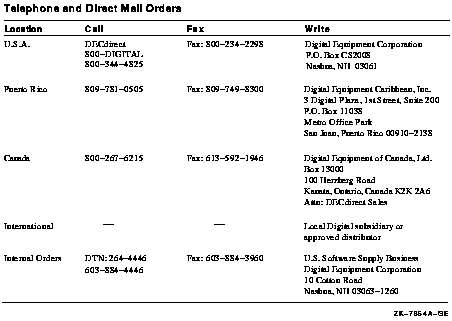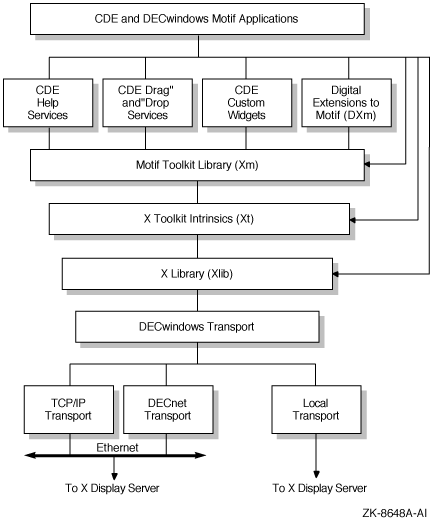Order Number: AA--QUW1A--TE
This manual is designed to enable DECwindows Motif general users, system managers, and programmers to successfully use the New Desktop, the alternate desktop provided with DECwindows Motif for OpenVMS Alpha.
Revision/Update Information: This is a new manual.
Operating System: OpenVMS Alpha Version 6.2
Software Version: DECwindows Motif Version 1.2--4 for OpenVMS Alpha
Digital Equipment Corporation Maynard, Massachusetts
Digital Equipment Corporation makes no representations that the use of its products in the manner described in this publication will not infringe on existing or future patent rights, nor do the descriptions contained in this publication imply the granting of licenses to make, use, or sell equipment or software in accordance with the description.
Possession, use, or copying of the software described in this publication is authorized only pursuant to a valid written license from Digital or an authorized sublicensor.
Digital conducts its business in a manner that conserves the environment and protects the safety and health of its employees, customers, and the community.
© Digital Equipment Corporation 1996. All rights reserved.
The following are trademarks of Digital Equipment Corporation: Bookreader, DECdirect, DECwindows, Digital, OpenVMS, OpenVMS Cluster, VAX, VAX DOCUMENT, VAXcluster, VMS, VMScluster, and the DIGITAL logo.
The following are third-party trademarks:
Hewlett-Packard is a registered trademark of Hewlett-Packard Company.
IBM is a registered trademark of International Business Machines, Inc.
Motif, OSF, OSF/1, OSF/Motif, and Open Software Foundation are registered trademarks of the Open Software Foundation, Inc.
Mosaic is a trademark of the University of Illinois.
NFS is a registered trademark of Sun Microsystems, Inc.
Novell is a registered trademark of Novell, Inc.
Sun is a registered trademark of Sun Microsystems, Inc.
UNIX is a registered trademark in the United States and other countries licensed exclusively by X/Open Co. Ltd.
Windows is a registered trademark of Microsoft Corporation.
All other trademarks and registered trademarks are the property of their respective holders.
ZK6469
The OpenVMS documentation set is available on CD-ROM.
This document was prepared using DECdocument, Version V3.3-1e.
| Contents | Index |
This manual is designed for users of the New Desktop component of DECwindows Motif Version 1.2-4 for OpenVMS Alpha. It provides information for general users, system managers, and programmers.
This manual is for all types of users. Table 1 shows the chapters and their intended audience.
| Chapter | Title | Intended Audience |
|---|---|---|
| 1 | Overview of the New Desktop | All users |
| 2 | Using the New Desktop | All users |
| 3 | Managing the New Desktop | System managers and advanced users |
| 4 | Integrating Applications into the New Desktop | Programmers |
| 5 | New Desktop Programming Resources | Programmers |
The documents related to this manual are shown in Table 2.
| Document | Description |
|---|---|
| DECwindows Motif Version 1.2--4 for OpenVMS Release Notes | Provides new features as well as release notes. |
| DECwindows Motif Version 1.2--4 for OpenVMS Installation Guide | Provides a detailed description of the installation procedure. |
| Guide to the DECwindows Motif Version 1.2--4 for OpenVMS CD--ROM | Includes a list of all the files on the kit, including the CDE manuals and this manual in HTML format. |
| CDE manuals | Developed by UNIX vendors. They are available on the kit in HTML format and also in print, as shown in Section 1.8.1. |
For additional information on OpenVMS products and services, access the Digital OpenVMS World Wide Web site. Use the following URL:
http://www.openvms.digital.com |
Digital welcomes your comments on this manual.
Print or edit the online form SYS$HELP:OPENVMSDOC_COMMENTS.TXT and send us your comments by:
| Internet | openvmsdoc@zko.mts.dec.com |
| Fax | 603 881-0120, Attention: OpenVMS Documentation, ZK03-4/U08 |
|
OpenVMS Documentation Group, ZKO3-4/U08
110 Spit Brook Rd. Nashua, NH 03062-2698 |
Use the following table to order additional documentation or information. If you need help deciding which documentation best meets your needs, call 800-DIGITAL (800-344-4825).

The name of the OpenVMS AXP operating system has been changed to OpenVMS Alpha. Any references to OpenVMS AXP or AXP are synonymous with OpenVMS Alpha or Alpha.
In this manual, every use of DECwindows and DECwindows Motif refers to DECwindows Motif for OpenVMS software.
The following conventions are also used in this manual:
|
MB1 (Select)
MB3 (Menu) |
MB1 indicates the left mouse button, and MB3 indicates the right mouse button. |
| Ctrl/ x | A sequence such as Ctrl/ x indicates that you must hold down the key labeled Ctrl while you press another key or a pointing device button. |
| [Return] | In examples, a key name enclosed in a box indicates that you press a key on the keyboard. (In text, a key name is not enclosed in a box.) |
| ... |
Horizontal ellipsis points in examples indicate one of the following
possibilities:
|
|
.
. . |
Vertical ellipsis points indicate the omission of items from a code example or command format; the items are omitted because they are not important to the topic being discussed. |
| ( ) | In command format descriptions, parentheses indicate that, if you choose more than one option, you must enclose the choices in parentheses. |
| [ ] | In command format descriptions, brackets indicate optional elements. You can choose one, none, or all of the options. (Brackets are not optional, however, in the syntax of a directory name in an OpenVMS file specification or in the syntax of a substring specification in an assignment statement.) |
| { } | In command format descriptions, braces indicate a required choice of options; you must choose one of the options listed. |
| boldface text |
Boldface text represents the introduction of a new term or the name of
an argument, an attribute, or a reason.
Boldface text is also used to show user input in Bookreader versions of the manual. |
| italic text | Italic text indicates important information, complete titles of manuals, or variables. Variables include information that varies in system output (Internal error number), in command lines (/PRODUCER= name), and in command parameters in text (where device-name contains up to five alphanumeric characters). |
| UPPERCASE TEXT | Uppercase text indicates a command, the name of a routine, the name of a file, or the abbreviation for a system privilege. |
| monospace type |
Monospace type indicates code examples and interactive screen displays.
In the C programming language, monospace type in text identifies the following elements: keywords, the names of independently compiled external functions and files, syntax summaries, and references to variables or identifiers introduced in an example. |
| - | A hyphen at the end of a command format description, command line, or code line indicates that the command or statement continues on the following line. |
| numbers | All numbers in text are assumed to be decimal unless otherwise noted. Nondecimal radixes---binary, octal, or hexadecimal---are explicitly indicated. |
This chapter provides information about the following topics:
The Common Desktop Environment (CDE), based on Motif and X11, is recognized as the next-generation desktop. CDE was created by a group of UNIX vendors (Hewlett-Packard, Sun, IBM, and Novell) to consolidate all the UNIX desktop interfaces and to define a consistent user and development environment.
CDE is built on existing technologies from these UNIX vendors and from
the Open Software Foundation, Inc. (OSF). CDE is not a replacement for
Motif; rather, it is another software layer on top of Motif, as shown
in Figure 1-1. CDE provides additional programming utilities and a
consistent, integrated user and development interface.
1.2 Why is Digital Offering CDE?
Digital adopted CDE for its Digital UNIX operating system and is providing a major subset of CDE for OpenVMS Alpha. As a successor to the DECwindows desktop, CDE is a state-of-the-art graphical user interface. This interface is visually appealing and offers many productivity features.
Standardizing the user interface enables general users and system
managers to work more effectively on systems from all vendors that
provide CDE. It also reduces training costs. Standardizing the
development environment for heterogeneous systems facilitates the
creation and maintenance of applications.
1.3 What is the New Desktop?
The implementation of CDE on OpenVMS Alpha is called the New Desktop. The user environment provided with previous releases of DECwindows Motif is the DECwindows desktop. DECwindows Motif forms the foundation of the New Desktop, as shown in Figure 1-1. Any application at the top level can directly call any of the lower levels.
Choosing the New Desktop does not prevent you from running DECwindows Motif applications. You can run any DECwindows application from the New Desktop using a DECterm window. Furthermore, all DECwindows applications can be configured to run within the New Desktop environment.
On OpenVMS Alpha, the New Desktop is the default desktop, although the traditional DECwindows desktop is also available. During installation or from the New Desktop login box, you can select your preferred desktop. After installation, a privileged user can switch between the two desktops by editing a system setup file and restarting DECwindows (see Section 3.2).
Figure 1-1 The New Desktop Architecture

You can become familiar with the New Desktop by using the documentation and applications in the following sequence:
The New Desktop provides many features not available in DECwindows Motif that enable users to be more productive in their work. Some of the most important productivity features follow.
Figure 1-2 Front Panel

The level of detail that is automatically saved and restored depends on the application. Some applications restore the entire visual state of the application at the point it was saved, while others restore only the main screen of the application. |
Table 1-1 lists all the CDE and DECwindows user applications that are integrated into the New Desktop and indicates the following information about each application:
In addition to the user applications that are integrated into the New Desktop, all DECwindows applications that were included in DECwindows Motif Version 1.2--3 are part of the New Desktop and are accessible from Application Manager. Note that two help viewers are provided with the New Desktop: Help Viewer for New Desktop help and Bookreader for DECwindows help.
| Application Name | Executable Name | CDE or DECwindows | Accessible From Front Panel |
|---|---|---|---|
| Action database and execution management utility (Create Action) | dtcreate | CDE | No |
| Action utility | dtaction | CDE | No |
| Application Manager, File Manager | dtfile | CDE | Yes |
| Bookreader | DECW$BOOKREADER | DECwindows | Yes 1 |
| Calculator | dtcalc | CDE | No |
| Calendar | DECW$CALENDAR | DECwindows | Yes |
| Clock | DECW$CLOCK | DECwindows | No 2 |
| DECterm | DECW$TERMINAL | DECwindows | Yes |
| Front Panel, Workspace Manager | dtwm | CDE | --- |
| Help Print utility | dthelpprint | CDE | No |
| Help Viewer | dthelpview | CDE | Yes |
| Icon Editor | dticon | CDE | Yes 3 |
| DECW$MAIL | DECwindows | Yes | |
| Print Dialog | PRINTDIALOG | DECwindows | Yes 4 |
| Session Manager | dtsession | CDE | No |
| Style Manager | dtstyle | CDE | Yes |
| Text Editor | dtpad | CDE | Yes 3 |
| Trash Can | dtfile | CDE | Yes |
| Watch Errors | DECW$MESSAGEPANEL | DECwindows | No |
| Next | Contents | Index |